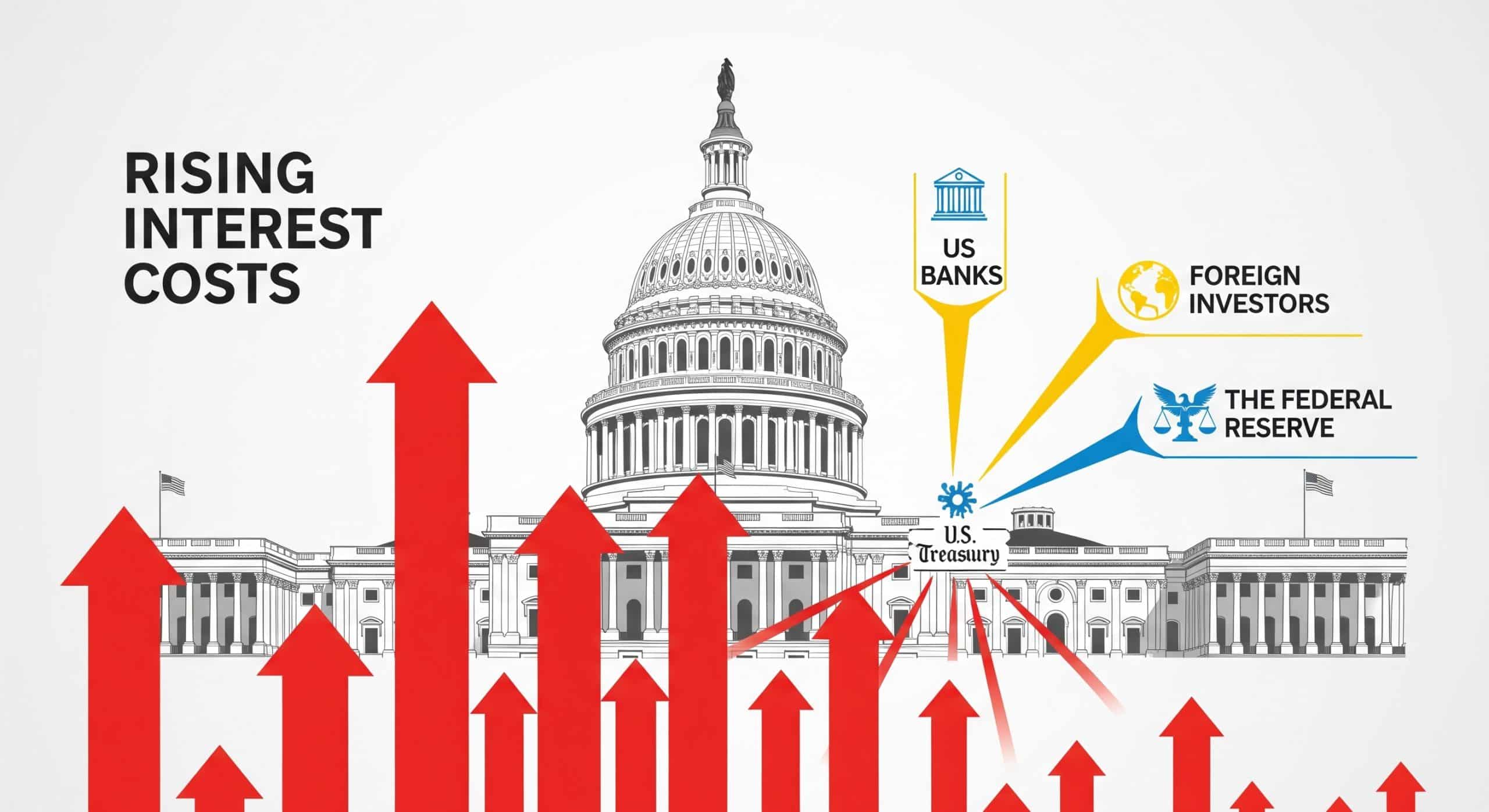U.S. Interest Payments Hit Historic Levels: Where Does All the Money Go?
The U.S. government’s interest expenses have surged to unprecedented heights. According to Treasury data, Washington has already paid $1 trillion in interest on federal debt during the first 10 months of fiscal year 2025 — the highest figure ever recorded for this period. At the current pace, total interest costs are set to exceed $1.2 trillion by year-end, marking the first time in history the U.S. will cross that threshold.
Interest Becomes the Second-Largest Federal Outlay
Over the past 12 months, gross interest payments have already hit a record $1.2 trillion, overtaking both defense and healthcare spending, each of which stood at roughly $900 billion. The only line item larger is Social Security, which now exceeds $1.5 trillion annually. The implications are striking: interest costs are no longer a side effect of fiscal policy but a dominant component of the federal budget.
Where Do the Interest Payments Actually Go?
Contrary to popular perception, the money spent on interest does not vanish. Instead, it flows into the hands of three primary groups of creditors:
First, a significant share of payments goes to U.S. financial institutions and banks, which hold Treasury securities as part of their capital management. These payments provide them with steady, low-risk income streams.
Second, domestic and foreign investors are major beneficiaries. Pension funds, mutual funds, and private investors within the U.S. receive interest as part of their bond holdings. Meanwhile, overseas holders — particularly in Japan, China, and Europe — earn tens of billions annually from U.S. interest obligations, effectively transferring American taxpayer dollars abroad.
Third, a substantial portion of the debt is held by the Federal Reserve itself. Following years of quantitative easing, the Fed owns trillions in Treasuries. While the Treasury pays interest on these holdings, the Fed ultimately remits most of its earnings back to the Treasury as surplus transfers, slightly offsetting the overall burden.
Fiscal and Structural Implications
The fact that interest costs have overtaken nearly every other category of federal spending is a flashing red signal. Every dollar allocated to debt service is a dollar not invested in infrastructure, education, or innovation. This dynamic risks locking the U.S. into a debt spiral, where rising interest obligations force higher borrowing, which in turn compounds future interest expenses.
The international dimension is equally concerning. With foreign creditors holding a large share of U.S. Treasuries, billions in interest payments are funneled overseas each year. This creates a structural dependency on global capital markets, limiting Washington’s fiscal flexibility and amplifying vulnerabilities in periods of geopolitical tension.
Looking Ahead
If current trends persist, 2025 will be remembered as a turning point in America’s fiscal history. The central question is whether policymakers and the Federal Reserve can rein in this trajectory — either through lower interest rates, deficit reduction, or structural reforms to the budget. Without intervention, a growing share of federal resources will be consumed by servicing past debts rather than shaping the nation’s future.
Comparison, examination, and analysis between investment houses
Leave your details, and an expert from our team will get back to you as soon as possible
* This article, in whole or in part, does not contain any promise of investment returns, nor does it constitute professional advice to make investments in any particular field.
To read more about the full disclaimer, click here- Articles
- •
- 6 Min Read
- •
- ago 3 minutes
 A Surge in U.S. Business Applications: Why Entrepreneurship Is Rising Despite Economic Headwinds
A Surge in U.S. Business Applications: Why Entrepreneurship Is Rising Despite Economic Headwinds
A Surge in U.S. Business Applications: Why Entrepreneurship Is Rising Despite Economic Headwinds At a time when economic indicators in
- ago 3 minutes
- •
- 6 Min Read
A Surge in U.S. Business Applications: Why Entrepreneurship Is Rising Despite Economic Headwinds At a time when economic indicators in
- Articles
- •
- 18 Min Read
- •
- ago 1 hour
 CHINA’S NEW HOME PRICE DECLINES PERSIST BUT NARROW MODESTLY IN MAJOR CITIES
CHINA’S NEW HOME PRICE DECLINES PERSIST BUT NARROW MODESTLY IN MAJOR CITIES
Analyzing the Factors behind China's New Home Price Declines and Their Impact on Major Cities China is experiencing a notable
- ago 1 hour
- •
- 18 Min Read
Analyzing the Factors behind China's New Home Price Declines and Their Impact on Major Cities China is experiencing a notable
- Articles
- •
- 19 Min Read
- •
- ago 2 hours
 OPENDOOR IS SURGING AGAIN AFTER JULY’S MEME-LIKE RALLY. HERE’S WHY.
OPENDOOR IS SURGING AGAIN AFTER JULY’S MEME-LIKE RALLY. HERE’S WHY.
The Factors Behind Opendoor's Recent Surge Post July's Meme-Like Rally Opendoor has seen a remarkable surge in its stock value
- ago 2 hours
- •
- 19 Min Read
The Factors Behind Opendoor's Recent Surge Post July's Meme-Like Rally Opendoor has seen a remarkable surge in its stock value
- Articles
- •
- 18 Min Read
- •
- ago 2 hours
 FINANCE MINISTER SAYS JAPAN MUST WATCH ECONOMIC BACKDROP TO CALLS FOR BOJ RATE HIKE
FINANCE MINISTER SAYS JAPAN MUST WATCH ECONOMIC BACKDROP TO CALLS FOR BOJ RATE HIKE
The Implications of Japan's Economic Backdrop on Calls for a BOJ Rate Hike Japan's economic landscape is currently under the
- ago 2 hours
- •
- 18 Min Read
The Implications of Japan's Economic Backdrop on Calls for a BOJ Rate Hike Japan's economic landscape is currently under the












